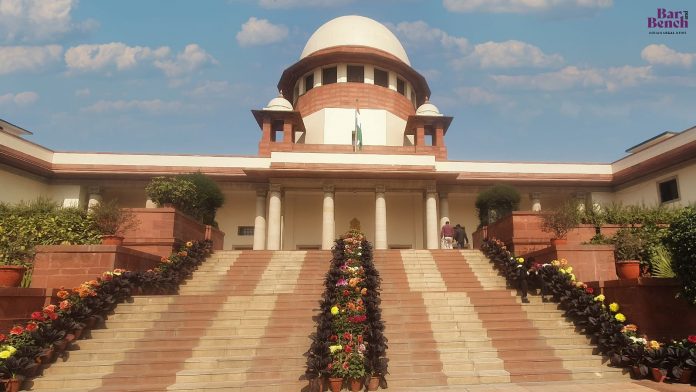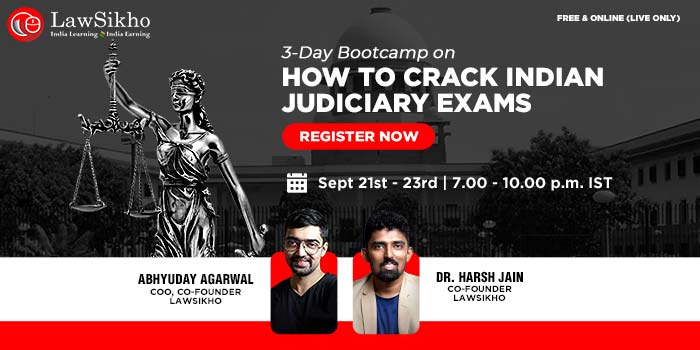

This article is written by Shiwangi Singh, a law student from Banasthali University. This article deals with the events that led to the establishment of today’s Supreme Court of India, the dual form of government in Bengal, the repercussions it caused, and how its damages were cured. It talks about the establishment of new Supreme Courts in Bombay and Madras and also the events that led to the establishment of today’s Supreme Court in India.
It has been published by Rachit Garg.
Table of Contents
The Supreme Court of India is the custodian of the Constitution. It upholds and uplifts the rule of law and also ensures and protects citizens’ rights and liberties. It upholds our Indian Constitution. There were numerous events in the history of India that paved the way for the establishment of today’s Supreme Court of India. Many Acts were passed during British rule which demanded the setting up of a Supreme Court. Earlier, there was more than one Supreme Court, but eventually, only one apex was decided, which now resides in New Delhi.

The Supreme Court of India holds the place of highest judicial power in our country where the final appeal regarding any matter is made. Earlier, during the British reign, The Government of India Act, 1935 worked as our governing book, which was further replaced and our country adopted its own constitution on January 26, 1950, and declared itself a ‘Sovereign’ ‘Democratic’ ‘Republic’. The Supreme Court of India was established on this day, but it started to function two days after India became a Republic on January 28, 1950. The Chamber of Princes, which was present in the Parliament House, was the first residence of the Supreme Court, later, it moved into the current building in 1958. It was the Chamber of Princes in the Parliament premises where the opening ceremony of the Supreme Court of India was held. On 29 October 1954, Dr. Rajendra Prasad, the first President of India, laid the foundation stone of the Supreme Court building.
The British, according to their convenience, enacted the Government of India Act, 1935, which had provisions for forming a federal court in India, which would be vested with more judicial powers than the High Court, including original, appellate, and advisory jurisdiction. After the Constitution of India was adopted, this federal court resumed working as the Supreme Court of India, presided over by Hon’ble Justice Harilal Jekisundas Kania.
Article 124(1) of the Constitution states that there should be a Supreme Court in India that would consist of one Chief Justice of India along with seven additional judges. The parliament then passed a precedent for increasing the number of judges.
The Regulating Act, 1773 also known as the East India Company Act, 1772, was an Act of the British Parliament introduced to establish a central administrative system in India to improve the governance of the East India Company’s rule in India. It was the stepping stone toward parliamentary control over the company. The British Government recognized the company’s political and administrative functions for the first time through this Act. Under this Act, the British East India Company had to carry out its administrative functions under the supervision of the British Parliament and submit its report regarding the revenue, civil, and military functions to the court of directors.
Robert CIive set up the dual system of government administration in Bengal after the Treaty of Allahabad (1765). The establishment of a dual form of government that persisted from 1765 to 1772 gave birth to many problems and led to the establishment of a corrupt government. Robert Clive introduced this system after he became the governor-general of Bengal in May 1765.
All these practices were required to be abolished, and new rules had to be made for better law and order. The Regulating Act held great importance as it looked after the company’s functioning.
Overall, this Act brought the concept of the Supreme Court to the apex along with the parliamentary administration of the East India Company. It regulated the working and kept a keen check on the functioning of the company.
Section 13 of the Regulating Act 1773 made a detailed provision for the establishment of a Supreme Court of judicature at Fort William, in Calcutta. This Supreme Court consisted of a chief justice and three other judges of higher rank but inferior to the chief justice. The British King appointed the judges. A barrister working for five years was qualified for the appointment as a Supreme Court judge. The judges held office under the orders of the crown and could also be removed by the crown.
Sir Elijah Impey was the first Chief Justice of the Supreme Court of Calcutta. The judges at the Supreme Court of India had the same powers and authority as the judges that sat in the court of the King’s Bench in England. They followed common laws and rules in both places.
The Supreme Court of Calcutta was the first British court consisting of lawyer judges in India. It was the first court that was fully independent in its jurisdiction and the company had no say in its decision-making after the process; it was a completely free wing and also worked diligently in carrying out its process. Its jurisdiction was extensive, covering large areas and a greater deal of matters happening around. It had control over Madras, Bengal, and Bombay. It had five kinds of jurisdiction namely-
It had its own way of process and practice and did all the things required for the administration of justice.
The civil jurisdiction of the court was of two types- territorial and personal. In Calcutta, the Supreme Court had territorial jurisdiction, which meant all the matters happening within the presidency of Calcutta fell under the jurisdiction of the Supreme Court. This Supreme Court held the same power to form laws, and pass orders as the High Court of Chancery in Great Britain had at that time.
The criminal jurisdiction of the Supreme Court was extensive and covered all the British matters that arose in Kolkata and within the territories of Bengal, Bihar, and Orrisa. Only the British officials and the servants who were employed with the company were covered under this jurisdiction, other natives were not part of the court’s jurisdiction.

The Supreme Court in India followed the rules of the English Courts. It worked as a court of Oyer and Terminer, and Gaol Delivery in and for the town of Calcutta, the factory of Fort William, and the other factories in Calcutta. The court cannot hold a trial for the Governor-General and the members of his council or the judges of the Supreme Court except if it is a very high criminal case of betraying its own country or felony. The mercy petitions were transferred to the Crown Court in England on the recommendations of the Supreme Court.
The Supreme Court regulated the civil and maritime cases that occurred on the high seas at that time.
The Supreme Court had the same jurisdiction over the British subjects in India as the ecclesiastical courts in England at that time.
This Amending Act of 1781 was brought up to rectify the defects caused by the Regulating Act of 1773. A huge amount of tension was present between the Supreme Court and the Governor-General, therefore this Act was passed to reduce the power of the Supreme Court and enhance the power of the Governor-General and his council members again. The servants and staff who worked under the company and fell under the Supreme Court’s jurisdiction now were exempted from its jurisdiction. Now, the court’s jurisdiction became limited to Calcutta. After the implementation of this Act, the Supreme Court had no jurisdiction on the matters of revenue, the government became independent of the control of the Court in the matter of revenue. The Governor-General and his council members gained power over judicial matters as appeals were now made to them instead of provincial courts. This Act strengthened the position of the Council so that they could easily govern according to their convenience and exercise control over India.
The main positive change brought by this Act was to protect the customs and traditions of the local people. The Act stated that all the matters arising among the people regarding land disputes, succession of property to the next heir, and all sorts of contracts and dealings between any parties will be decided as per their personal law. If there is a case between a Hindu and a Muslim then the case would be decided by following the law of the defendant.
The Supreme Court was given the authority to make rules and regulations according to the prevailing conditions and demands of the people, who would deal with their matters according to this law. Therefore, the laws were set according to their way of living. The laws formed were put in front of the British crown, who could accept, reject, or correct them.

The Supreme Courts at Madras and Bombay were established by King George III in 1800 and 1823 respectively. Earlier, Madras and Bombay had a recorder’s court whose judicial function was similar to that of the Supreme Court of Calcutta. But the recorder’s court did not function always which created a lag, and hence, it was replaced by Supreme Court.
These two new Supreme Courts had the same powers, jurisdiction, functions, and limitations as that of the Supreme Court at Calcutta. The Act of 1823 clearly mentioned in Section 17 that the newly established Supreme Courts at Madras and Bombay would have the power to administer, carry out duties, and hold powers of the same magnitude as the Supreme Court at Fort William in Calcutta. This provision bestowed equal power and framed them in an equal place without altering any power or duty of the newly formed Supreme Courts.
These Supreme Courts functioned for a long period of time until 1862, when the high court came into force in all these three places through the Indian High Courts Act, 1861.
On January 26, 1950, the Constitution of India came into force and the Supreme Court of India came into being. The legal proceedings started two days later, on January 28. The inauguration ceremony took place in the Parliament building at the Chamber of Princes, the same place where the Federal Court of India once functioned. The inaugural proceedings started at 9:45 a.m. and were presided over by the judges of the Federal Court – Chief Justice Harilal Kania and Justices Saiyid Fazl Ali, M. Patanjali Sastri, Mehr Chand Mahajan, Bijan Kumar Mukherjea, and S.R. Das.
Several other Chief Justices of the High Court attended the inauguration ceremony. Attorney General of India, and many Advocate Generals of Bombay, Madras, Uttar Pradesh, and Bihar were present.
After its inauguration, on January 28, 1950, the Supreme Court commenced its sittings in a part of the Parliament House. Later, it moved to the current building in 1958.
The Supreme court is the Apex Court and there can only be a single Apex Court in any country. The name itself suggests that a supreme power can only be present in one place which would control the activities of other subordinate courts. If the supreme authority is present in multiple places, then it would create tension in making uniform laws and passing uniform judgments. Today, the judgments passed by the Supreme Court are followed in every court across the country. If there would have been multiple Supreme Courts then this uniformity of following laws and judgments would definitely get hampered.
The issues taken to the Supreme Court could be transferred to a larger judge bench for better decision making but creating multiple Supreme Courts would create a clash of judgments.
Recently the Government has also clarified the rumours which stated that more branches of the Supreme Court are opening in Chennai, Mumbai and Kolkata. The Press Information Bureau (PIB) stated in a tweet that this claim is fake, and no such decision has been taken by the government.
The Supreme Court is the body of the highest appeal where the last proceedings of any matter can be taken. It gives equal opportunity to everyone to seek justice. The Acts mentioned above paved a way for its establishment. The Regulating Act brought central administration and Parliament control with the Supreme Court acting as a supreme judicial body. The Act of the Settlement also tried to curb the defects of the Regulating Act. Both the acts were pioneers of new reform, however, both held certain drawbacks, as well. But today, the Supreme Court stands at the top of our judicial wing and functions diligently and also regulates the laws for the lower to function according to the current situation prevailing.
Sir Elijah Impey was the first chief justice of the supreme court at Fort William, Calcutta.
The functions of the Supreme Court are:
Article 32 of the Indian Constitution gives the right to individuals to seek justice when they feel that their right has been ‘unduly deprived’.
On January 28, the Supreme Court began to function, this day marks the establishment of the Supreme Court.
Justice Harilal Jekisundas Kania assumed the office as the first Chief Justice of India.
Warren Hasting was the first governor-general of Bengal appointed in the year 1773.
Nizamat rights are the judicial and policing rights, while Diwani rights are the rights to collect revenue.